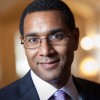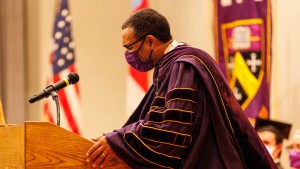Early in the tremendous novel “Their Eyes Were Watching God,” the young inexperienced protagonist Janie, looking at a future rife with uncertainty, tries to square the immediate choices ahead of her with her hopes and dreams. Capturing the feeling of this context, Zora Neale Hurston writes, “There are years that ask questions and years that answer.” As we stand at the end of the year 2021, and as you stand at the conclusion of your Kenyon careers, this quote resonates deeply.
We are approaching the two-year anniversary of the official news of the discovery of a novel coronavirus, SARS-CoV-2, that was responsible for a new infectious respiratory disease. Many of us missed the story as it was first announced, and likely none of us understood the impact of this discovery: to date more than 5 million lives lost worldwide, 800,000 in the U.S., and the disruption of the lives of many, all around the world. Indeed, the past two years have asked many fundamental questions about our lives, about our responsibility to others, and about the limitations of our institutions.
Like Janie, we all face questions (and sometimes answers) brought to us by external circumstance. Yet we do not stop there; we are not only passive actors upon whom the world imposes its queries. Not only do we face questions and answers brought to us, but also we seek them.
Hurston, a formally trained ethnographer, knew this well and modeled this spirit throughout her life and her scholarship. In her autobiography “Dust Tracks in the Road” Hurston defines research as “formalized curiosity … poking and prodding with a purpose.”
I’ve always been attracted to this notion of research — grounded in curiosity, drawing upon the playful and exploratory concepts of “poking and prodding,” but coupling it to the importance of purpose. In fact, I think this reflects not only the ethos of research, but rather a key set of tools we take from a liberal arts education, and perhaps even the ideas that drew you to Kenyon initially. These tools are invaluable not only in approaching phenomena like the COVID crisis but also in our day-to-day lives.
To illustrate this, perhaps unsurprisingly, I’d like to offer one last chemistry lecture and take a detour to talk about the molecules behind COVID, the work of scientists in “poking and prodding with a purpose,” how this has been built upon decades of formalized curiosity, and how this process helps all of us to resolve the uncertainties ahead of us.
Modeling the molecular structure of the SARS-CoV-2 coronavirus progressed very quickly after the initial discovery. The genome of the new coronavirus was published in mid-January, allowing for the synthesis and expression of genes responsible for each protein; producing protein in the laboratory by biochemists permitted the solutions of the three-dimensional structures; and these molecular structures, depicted by what chemists call space-filling models, gave the details to what is now broadly recognized as the spiky soccer ball image that accompanies news articles and, in somewhat questionable taste, graces t-shirts and coffee mugs.
Yet this work was built upon more than a half century of “poking and prodding,” including the work that underlies the models and images themselves. The iconography of these images can be traced to the work by Linus Pauling and his longtime collaborator Robert Corey. Pauling had been responsible for codifying the modern principles of molecular structure in his landmark book “The Nature of the Chemical Bond,” published in 1939 but still in print (and relevant today). By the mid-20th century, Pauling had turned his attention to understanding the structural principles of large molecules responsible for biological activity, especially proteins; and as he and his colleagues collected data on protein structures, they needed new tools for building physical models of molecules.
The standard tools of model building (dating back to at least 1865) were “ball and stick” models, with atoms represented by balls connected by sticks, representing bonds (sort of like pieces of clay connected by toothpicks). Corey and Pauling developed models that were solid objects, making visible the surface details, emphasizing the bumps, the nooks and crannies, the general topography of the electron clouds. Their 1953 paper entitled “Molecular Models of Amino Acids, Peptides, and Proteins,” an article which reads like an instruction guide for the fabrication of small wood and plastic pieces, revolutionized the way that we visualize systems like the coronavirus.
And Pauling’s instincts were correct: the details of the surface, subtle changes in the structure that are best deduced by manipulation of space-filling models, are central to understanding how these molecules work. The act of holding these models (something today that we do virtually, with computer generated images, instead of Pauling’s wood and plastic structures) generates questions, answers, and yet new questions – a literal poking and prodding that helps to both satisfy and advance our curiosity.
The structural details of the proteins that make up the SARS-CoV-2 coronavirus allow us to evaluate the properties of newly emerging variants and design new drugs that can inhibit virus transmission. As we move our eyes along the surface of the coronavirus spike protein, especially as we compare the spike protein of one variant to another, there are features that capture our attention right away: places where positive charges on the surface are replaced, changes that suggest a physical mechanism for altering the capacity of the virus to stick to receptors on a host cell surface. Others suggest possible targets for the design of drugs that could inhibit transmission. Each poke, each prod, brings answers and raises questions; and carrying through this cycle eventually resolves both the uncertainty and the anxiety that the uncertainty generates.
During your time at Kenyon, you have honed your formalized curiosity, becoming practiced at poking and prodding with a purpose. And the results have the potential to impact not just your own growth and development, but — just as Pauling and Corey molded a new way of thinking of molecular structure out of wood and plastic — your work may open new ways to see the world, helping to answer questions that will arise years into the future.
Each of us will live through years that ask questions; this is a part of our fate as humans. These won’t always be global in nature or in scale, as with the pandemic; we all face moments of personal uncertainty, circumstances that raise doubts about ourselves and the choices we face, all of which can grow into an overwhelming and paralyzing sense of anxiety. One of the things you take with you from this Hill — a lasting impact of your time here — is extensive practice at curiosity, of poking and prodding with a purpose, that will be an invaluable tool at countering this anxiety and powering your resilience through moments of uncertainty.
Best wishes on your future adventures, and please keep in touch.
Thank you.

